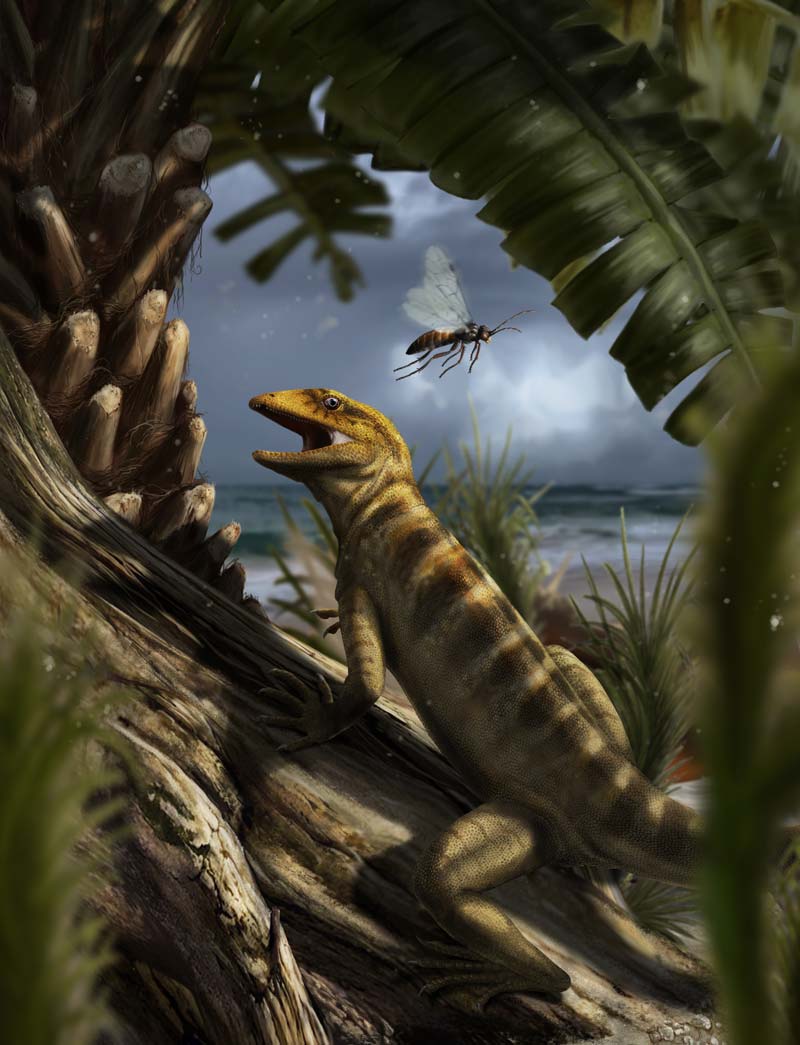
Megachirella as imagined by Davide Bonadonna
Paleontologists have identified the world's oldest lizard fossil, providing key insight into the evolution of modern lizards and snakes.
The 240-million year-old fossil, Megachirella wachtleri, is the most ancient ancestor of all modern lizards and snakes, known as squamates, a new study shows. An analysis of the fossil and data from both living and extinct reptiles-including anatomical data drawn from CT scans and DNA-suggests the origin of squamates is even older, taking place in the late Permian period more than 250 million years ago.
"The specimen is 75 million years older than what we thought were the oldest fossil lizards in the entire world," explained Tiago Simões, lead author and PhD student in the University of Alberta's Department of Biological Sciences. "This discovery provides valuable information for understanding the evolution of both living and extinct squamates."
Today, there are 10,000 species of lizards and snakes around the world-twice as many species as mammals. Despite this modern diversity, scientists don't know much about the early stages of their evolution. "It is extraordinary when you realize you are answering long-standing questions about the origin of one of the largest groups of vertebrates on Earth," added Simões.
"Fossils are our only accurate window into the ancient past," explained Michael Caldwell, professor of biology and co-author on the study. "Our new understanding of Megachirella is one point in ancient time, but it tells us things about the evolution of lizards that we simply cannot learn from any of the species of lizards and snakes alive today."
The study comes just three years after Caldwell's 2015 discovery of an ancient lizard fossil that showed the evolution of snakes took place much earlier than previously thought.
Originally overlooked
Researchers once thought the fossil, which was originally found 20 years ago, was linked to but not an ancestor of modern lizards and snakes. But further analysis by an international team of researchers at the U of A as well as Italy and Australia determined that the specimen was actually the oldest relative ever found of all living lizards and snakes.
To complete the study, Simoes and his supervisor, U of A paleontologist Michael Caldwell, professor and chair in the Department of Biological Sciences, assembled the largest phylogenetic dataset ever. The pair combined data from fossils and living specimens from more than 130 lizards and snakes collected over four years. The data included CT scans, photographs and molecular analysis collected by Simoes and Caldwell, rather than relying on existing literature.
Originally found 20 years ago in the Dolomites Mountains, a UNESCO World Heritage Site in Northern Italy, researchers considered it an enigmatic lizard-like reptile but could not determine its relation to modern squamates.
In order to better understand both the anatomy of Megachirella and the earliest evolution of lizards and snakes, Simões assembled the largest reptile dataset ever created, data from fossils and living specimens from more than 130 lizards and snakes from around the world, collected over four years.
The researchers combined this data with CT scans obtained at the ICTP-Elettra facilities in Trieste, Italy, revealing that Megachirella was actually the oldest known squamate.
"At first I did not think Megachirella was a true lizard, but the empirical evidence uncovered in this study is substantial and can lead to no other conclusion," said co-author Randall Nydam of Midwestern University.
"This is the story of the re-discovery of a specimen that highlights the importance of preserving naturalistic specimens in well-maintained, publicly accessible collections," added co-author Massimo Bernardi from MUSE Science Museum in Italy and the University of Bristol. "New observations, that could arise from the use of new techniques such as mCT data we have obtained here, could provide a completely new understanding even of long-known specimens.
"The Origin of Squamates Revealed by a Middle Triassic Lizard From the Italian Alps" was published in Nature, one of the world's leading academic journals (doi: 10.1038/s41586-018-0093-3).